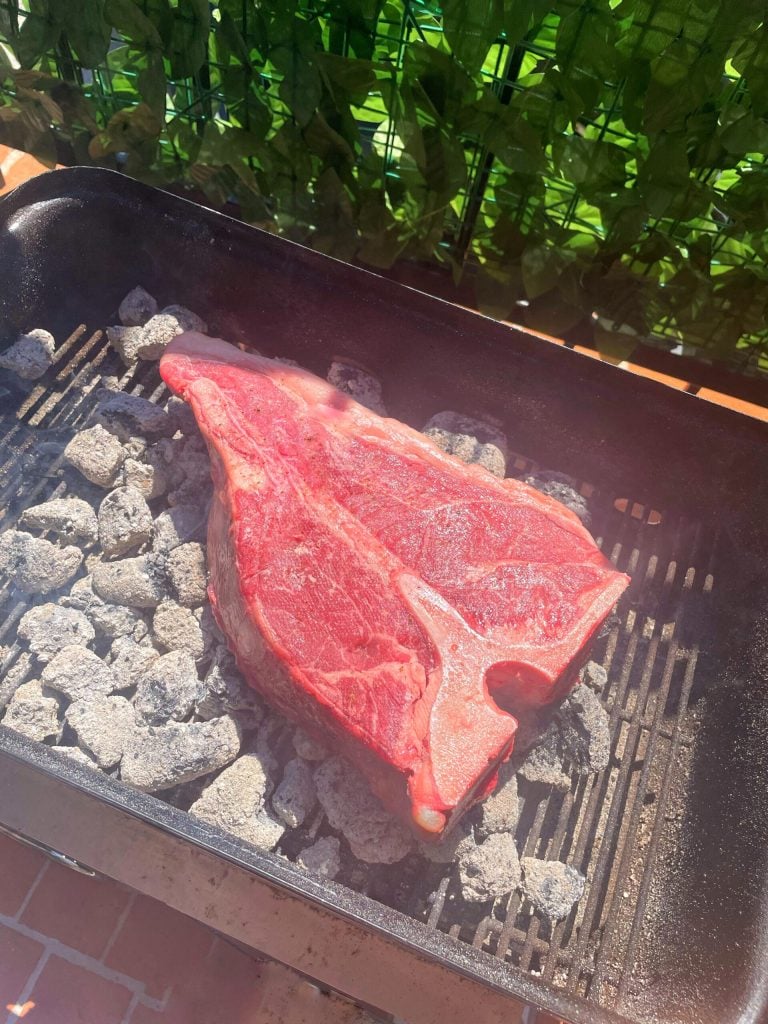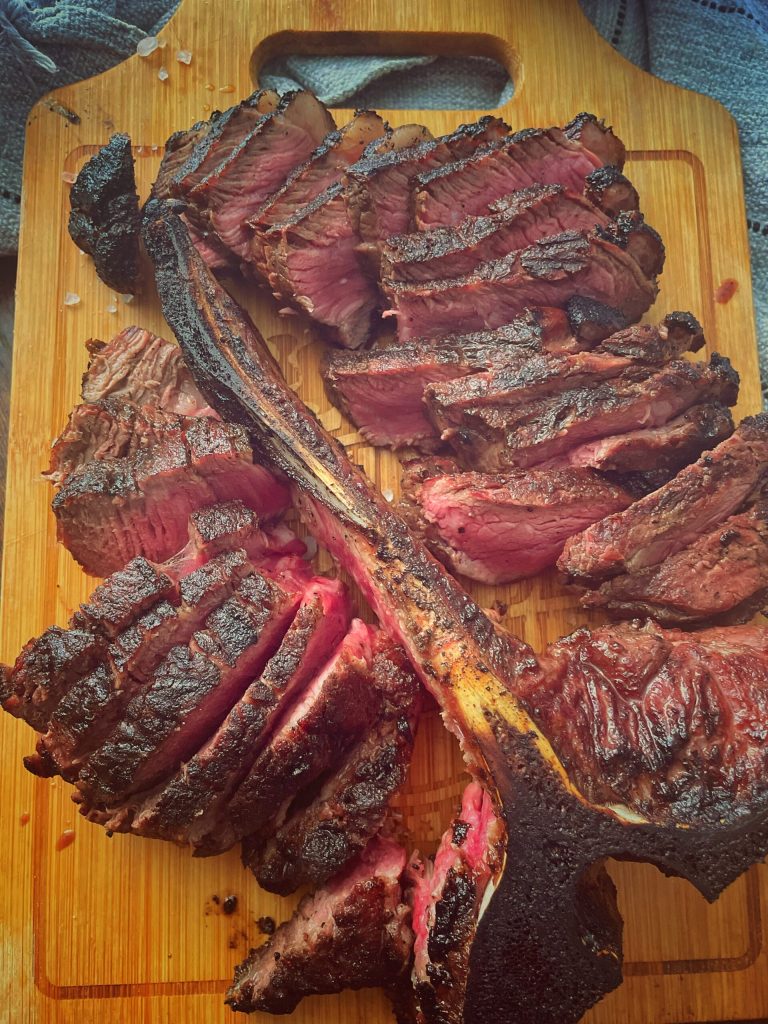For the Porterhouse I chose the *Caveman style*:
an extremely primitive meat cooking method, which consists of cooking the steak directly on glowing embers, without a grill, pan, or other supports.
➡️The *Caveman style* (or “*like a caveman*”) is an extremely primitive meat cooking method, which consists of *cooking it directly on glowing embers*, without a grill, pan, or other supports. It is widely used by barbecue enthusiasts to enhance the smoky and natural flavor of the meat.
🔥 How it works:
– Use *natural charcoal or wood* lit until a layer of *red-hot embers* forms.
– Move excess ash and place *thick cuts of meat* directly on the embers.
– Cook for a few minutes on each side, achieving a *very intense and smoky crust*, while the inside remains juicy and rare or medium.
🥩 Ideal cuts:
– Ribeye steak
– Tomahawk
– Cowboy steak
– Thick fillet
– Rib steaks, Florentine steaks, T-bone, porterhouse
✅ Pros:
– Intense and smoky flavor
– No tools needed
– Quick cooking
⚠️ Caution:
– It is essential to use *quality natural charcoal*, not treated with accelerants.
– You can *brush off the meat afterwards with a brush* or pat it to remove charcoal residue.
– Better *not to salt beforehand*, to avoid drying the surface too quickly.
The porterhouse is a beef cut similar to the Florentine steak, but with a larger portion of fillet.
In practice, it is a cut found in the rear part of the loin, where the fillet is more developed.
In Italy, both the T-bone and the porterhouse are often called Florentine steak.

- Difficulty: Medium
- Cost: Very expensive
- Rest time: 5 Minutes
- Preparation time: 5 Minutes
- Portions: 1 Piece
- Cooking methods: Embers
- Cuisine: American
- Seasonality: All seasons
Ingredients
- 2.2 lbs porterhouse
- to taste natural charcoal
- to taste coarse salt
- to taste black pepper
Tools
- 1 Thermometer for meat
Steps
Bring the meat to room temperature before cooking it.
Pat it dry with paper towels.
Minimal seasoning: coarse salt and freshly ground black pepper.You can add a drizzle of oil AFTER the cooking.

Lay the meat directly on the live embers. No barriers, no grill.
Let it cook:
About 5-8 minutes per side for rare doneness.
Turn it only once, using a long tong.
Check the doneness using touch or a probe thermometer:
Rare → 122-126°F
Medium rare → 131-134°F
If necessary, move the meat to areas with fewer embers to avoid burning it.
After cooking:
Brush off any ash or embers using a clean kitchen brush.
Let the meat rest on a cutting board for 5-10 minutes covered with foil.
Season to taste with melted butter, herbs, olive oil, or a quick sauce.
If you want, you can wrap the bone (if present) in foil to protect it.
Don’t fear a little charcoal residue: it’s part of the authenticity of the method and gives a natural smoky flavor.
📲You can purchase it on the website:
www.gruppogalli.it/shop/ with my discount code ❌viaggiandomangiando❌
Like the one you see in the video.
FAQ (Frequently Asked Questions)
What is the difference between Porterhouse and T-Bone?
You can listen to this video.
Porterhouse:
Larger cut, with a larger portion of fillet compared to the T-bone.
T-bone:
The cut comes from the center of the loin, with a smaller portion of fillet.
In summary: The porterhouse is a T-shaped bone steak, distinguished by a greater presence of fillet compared to the T-bone.How does caveman style compare with other cooking methods?
Caveman Style | Directly on embers | Intense smoky flavor, rustic crust | Extreme “fire-kissed” flavor, show | Requires attention, residues on meat |
Direct Grill | Grill over charcoal | Quick cooking, crispy crust | Better control, less ash | Less smoky than caveman |
Reverse Sear | Indirect cooking + sear | Low initial temp, then fast sear | Uniform interior, crispy exterior | Longer and technical |
Sous-vide + Grill| Vacuum + grilled | Meat cooked at low temp then finished on the grill | Maximum precision | Requires specific equipment |
Smoking Low&Slow | Closed grill, indirect fire | Low temperature cooking for hours, aromatic wood | Intense aroma, extreme tenderness | Very long wait, less crust |
In summary, the Caveman style is perfect for thick cuts and those seeking intense, primal flavors, but it’s not suitable for those preferring precise cooking control or delicate finishes.What is the best charcoal for caveman style cooking?
For Caveman Style cooking, you need high-quality natural charcoal that produces dense embers, little ash, and no chemical flavors.
Here are some ideal charcoals:
🔹 Hardwood Lump Charcoal (Hardwood Lump Charcoal)
Made from natural woods like oak, hickory, acacia, or hornbeam.
Burns hot and clean, perfect for direct contact of meat with embers.
In Italy, you can find excellent charcoals of:
Oak (“leccio” or “rovere”)
Acacia charcoal (burns long, slightly smoky flavor)
🔹 Marabu Charcoal (Cuba)
Famous among expert grillers.
Burns slowly, produces few sparks, and lots of compact embers.
Great for those wanting a long cooking time without constant charcoal additions.
🚫 Not recommended:
Cheap supermarket charcoal (often compressed with chemical binders).
Standard briquettes (based on binders) → too much ash and unpleasant flavors.
Conclusion:
If you want the best for a Porterhouse or a Ribeye in Caveman style, I recommend a natural hardwood charcoal from oak or acacia, possibly certified without additives.

